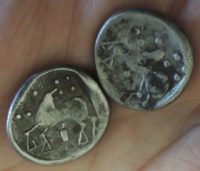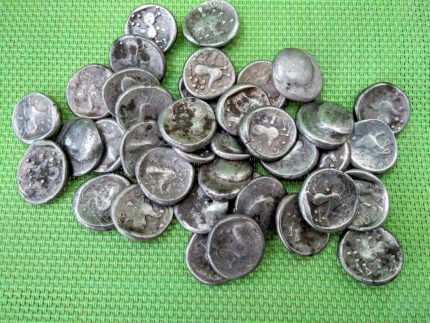 Archaeologists have discovered a hoard of Celtic coins from the early 1st century in the village of Mošovce, northern Slovakia. Forty silver tetradrachms were found scattered over a steep slope. This is the second largest coin hoard discovered in the area and the one with the oldest coins.
Archaeologists have discovered a hoard of Celtic coins from the early 1st century in the village of Mošovce, northern Slovakia. Forty silver tetradrachms were found scattered over a steep slope. This is the second largest coin hoard discovered in the area and the one with the oldest coins.
They date to the end of the La Tène period and were buried in the early 1st century around the turn of the millennium when the Romans occupied the area. The collapse of the Celtic civilization and the Roman invasions created social instability that may have spurred the burial of the coins, either to protect precious savings or as a ritual deposit to buy the protection of the gods.
They were originally buried in one place, wrapped in an organic material. The archaeologists identified the burial site. It broke down due to soil erosion, exposing the organic material to decay and the coins to scattering. Very few coin discoveries are made in their original context by archaeologists like this one was. Night hawks and looters run rampant, and if they get to a site at all, archaeologists are often beaten to the punch by treasure hunters. Because the coins and find site were untouched, the team was able to discover the extremely important burial location.
Tetradrachms are silver coins weighing nine to 10 grams, about four times the weight (and therefore value) of the smallest denomination, the drachma. In the 1st century, tetradrachms were the most valuable coin denominations minted in what is now northern Slovakia.
It is highly probable that they are minted from silver originating from a Carpathian (Slovak) deposit. The economic power of Celts in the Slovak area was to a considerable extent based on using natural resources, especially gold, silver and iron. The Turiec region belonged among the key economic and cultural centres of Celts in Slovakia, [Deputy Director of the Archaeological Institute of Slovak Academy of Sciences Karol] Pieta added. […]
Celtic coins are the oldest coins minted in the Slovak area. The finding proves that Slovakia is full of significant archaeological discoveries still hidden under the ground, thinks Matej Ruttkay, director of Archaeological Institute of SAV in Nitra.

The Drachma -or δραχμή- is in fact a Greek coin, as already in the late 3rd century, certain ‘withdrawals’ had been made.
Here, it seems, they had the form of a Rainbow cup (cf. the ‘Star Talers’ fairy tale).
“Accordingly, the Volcae, seized on those parts of Germany which are the most fruitful around the Hercynian forest, which, I perceive, was known by report to Eratosthenes and some other Greeks, and which they call Orcynia, settled there.” –Caesar
Though probably to be located in the eastern range of the České Středohoří; yet, the Volcae of his time were settled in Moravia, east of the Boii.
Maroboduus, the guy that the Romans knew as Arminius and Publius Quinctilius Varus probably knew each other from their time in Rome. About 9 BC, Maroboduus returned to Germania and became the ruler of his people.
After they were beaten by general Drusus, he led the Marcomanni from the Moenus basin to the area of Bohemia and took the title of king organizing a confederation of several neighboring Germanic tribes. He was the first documented ruler of Bohemia, and –arguably– also parts of what is now Slovakia.
After in 9AD those three Roman legions were annihilated, Arminius cut off Varus’ head and sent it to Bohemia as a present to Marbod, and possibly to coax an alliance, but Marbod declined the offer and sent the head on to Augustus in Rome :skull:
In 17 AD, war broke out between Arminius and Maroboduus, and after an indecisive battle, Catualda, a young Marcomannic nobleman then in exile among the Gutones, returned, perhaps by a subversive Roman intervention, and defeated Maroboduus into exile in Rome (actually, he was captured in Ravenna).
And what does that have to do with this post? 😮
I have never see coins like this, with a kind of hump-backed reverse side.